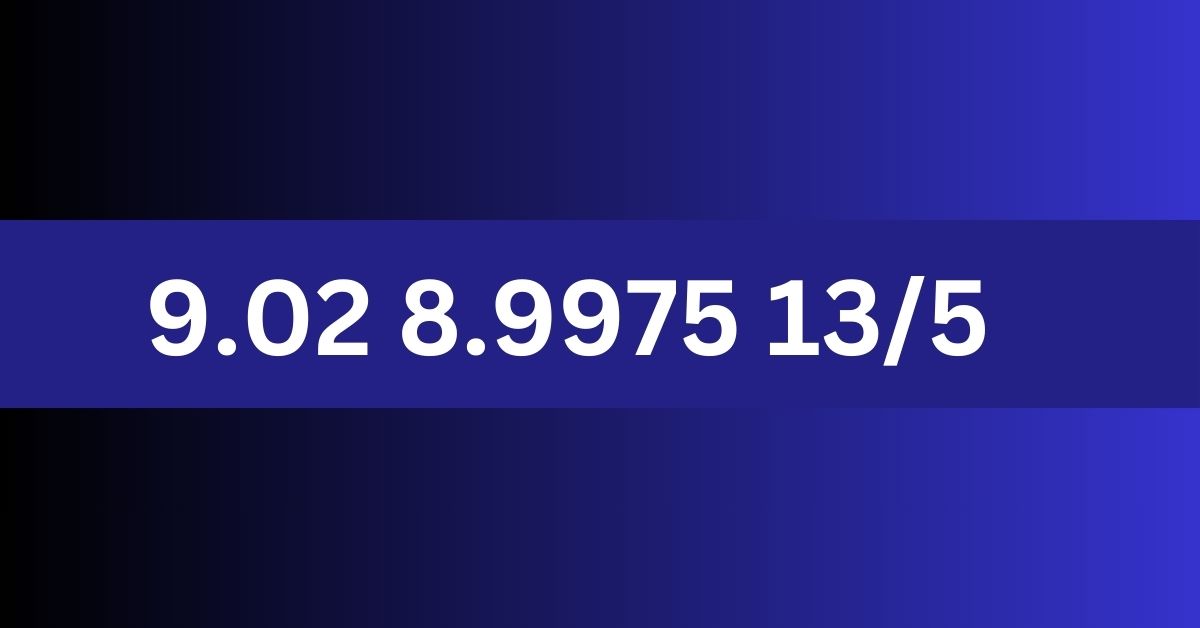9.02 8.9-975 13/5: Decoding the Numbers
9.02 8.9 975 13/5: Numbers surround us every day, each with a story to tell. Among them, you might come across intriguing values like 9.02, 8.9975, and the fraction 13/5. At first glance, they may seem just like digits on a page or calculations for your next budget plan. However, these numbers hold deeper meanings that can unlock insights into mathematics and daily life.
Have you ever wondered about the difference between decimal precision and fractional flexibility? Or how rounding affects our understanding of numerical significance? Whether you’re a math enthusiast or simply curious about how numbers play a role in various fields—from finance to science—decoding these figures opens doors to new perspectives.
Grab your calculator (or don’t) as we journey through the fascinating world of decimals and fractions! You’ll discover their applications in everyday scenarios while gaining valuable knowledge along the way.
Let’s dive into decoding what makes 9.028.9-97513/5 more than mere numbers—they are keys to comprehension in both academic realms and real-life situations alike!
9.028.9-97513/5: Understanding Decimal Numbers and Fractions
Decimal numbers and fractions are two fundamental ways to represent quantities. Decimals, like 9.02 or 8.9975, express values using a base-10 system that incorporates a decimal point. This point divides the whole number from the fractional part, making it easier for calculations in everyday life.
On the other hand, fractions such as 13/5 depict parts of a whole using two integers: a numerator and a denominator. The numerator indicates how many parts are considered, while the denominator shows how many equal parts make up one whole. Both formats convey similar information but do so through different lenses.
Decimals often provide more precision when measuring lengths or weights, especially in scientific contexts where accuracy is vital. Fractions offer flexibility in situations involving ratios or divisions that may not translate cleanly into decimals.
Understanding both representations expands your mathematical toolbox. Whether you’re cooking with measurements or calculating finances, knowing how to interpret decimals and fractions enhances problem-solving skills and sharpens numerical literacy.
9.028.9-97513/5: Exploring Decimal Precision and Fraction Flexibility
Decimal precision and fraction flexibility are two critical concepts in mathematics, each serving unique purposes. Decimals represent a specific value, allowing for fine distinctions between numbers 9.028.9-97513/5. For instance, 9.02 is slightly greater than 9 but less than 10. The additional digits after the decimal point provide clarity that can be crucial in calculations or measurements.
On the other hand, fractions like 13/5 offer a different perspective on numbers. They emphasize ratios rather than fixed positions on a number line. This flexibility allows for easier simplification and manipulation in various mathematical operations without losing the essence of what they represent.
When considering decimals versus fractions, one might notice how context influences their use. In everyday scenarios—such as cooking or budgeting—fractions can simplify tasks by providing clear proportions while decimals excel when precision is paramount, such as in scientific experiments or financial transactions.
Understanding both systems opens doors to better problem-solving strategies across disciplines. Whether you’re measuring ingredients for a recipe or calculating interest rates for savings accounts, knowing when to use decimals and when to lean into fractions can make all the difference.
9.028.9-97513/5: Applications in Everyday Life and Various Fields
Decimal numbers and fractions play a crucial role in our daily lives. From shopping to cooking, we constantly encounter scenarios where precise calculations matter. For instance, when buying groceries, understanding the price per unit can help you find the best deals.
In education, decimals and fractions are foundational concepts for students learning math. They are essential for solving problems related to measurement and data analysis. Teachers use these principles to instill problem-solving skills that students will carry into adulthood.
The business world also relies heavily on these number formats. Financial analysts use decimal precision when calculating interest rates or profit margins. In accounting, fractions may come into play when dividing resources among partners or determining equity shares.
Even in technology sectors like software development, numerical accuracy is paramount. Engineers often deal with measurements that require both decimal points and fractional representations for parts specifications or algorithmic computations. Each field uniquely highlights how critical it is to understand and manipulate these numbers effectively in real-world contexts.
9.02 8.9975 13/5: Rounding, Precision, and Mathematical Significance
Rounding is a vital mathematical tool that simplifies numbers for easier comprehension. When dealing with decimals like 9.02 and 8.9975, rounding helps convey the essential value without overwhelming detail. It’s about finding balance—retaining accuracy while making information digestible.
Precision plays a significant role in fields such as science, finance, and engineering. A minor difference can lead to substantial outcomes when it comes to measurements or calculations. For example, using 13/5 instead of its decimal equivalent may provide clarity in certain contexts while sacrificing precision in others.
Mathematical significance goes beyond mere numbers; it encompasses their implications and interpretations. The choice between decimals and fractions might seem trivial but could drastically affect understanding in various scenarios. Each format has unique advantages that cater to different needs.
In mathematics, every digit holds weight. Rounding down from 8.9975 to 9 changes not just the numeral but potentially alters perceptions too—whether it’s financial forecasting or scientific research results where every piece of data counts immensely.
9.02 8.9975 13/5: Future Implications and Importance
As we delve into the future of numerical understanding, the implications of precise calculations become increasingly significant. With advancements in technology and data analysis, numbers like 9.02, 8.9975, and fractions such as 13/5 will play pivotal roles in various domains including finance, engineering, and healthcare.
In fields driven by data accuracy—like artificial intelligence or machine learning—precision is paramount. The ability to distinguish between a value of 9.02 versus an approximation can mean the difference between success and failure in algorithms that rely on split-second decisions.
Moreover, education systems are evolving to focus more on critical thinking regarding decimals and fractions. This shift prepares students not just for exams but also for real-world applications where fluidity with numbers 9.02 8.9975 13/5 enhances problem-solving capabilities.
As globalization continues to grow, standardizing numerical representation becomes crucial across cultures. Understanding these nuances fosters better communication in international trade agreements or scientific collaborations where precision is key to trust and reliability among parties involved.
Conclusion
Decoding the numbers 9.02 8.9975 13/5 reveals much about how we interact with mathematics in our daily lives. Understanding decimal numbers 9.02 8.9975 13/5 and fractions allows us to see their various applications, from financial transactions to scientific measurements.
Precision is crucial in many fields, yet flexibility remains vital when interpreting data or adjusting calculations for practical use. Rounding can lead to more straightforward communication but might sacrifice accuracy if not handled carefully.
These concepts extend far beyond math class; they influence technology, finance, engineering, and healthcare as well. As industries evolve and require stricter precision standards or flexible interpretations of data sets, a solid grasp of these numerical forms will become increasingly important.
As we navigate a world filled with complex information presented through numbers 9.02 8.9975 13/5, being equipped with the knowledge of decimals and fractions enables us to make informed decisions every day—whether we’re budgeting at home or analyzing research data at work. Understanding these elements strengthens our analytical skills while fostering confidence in our mathematical abilities across all walks of life.







